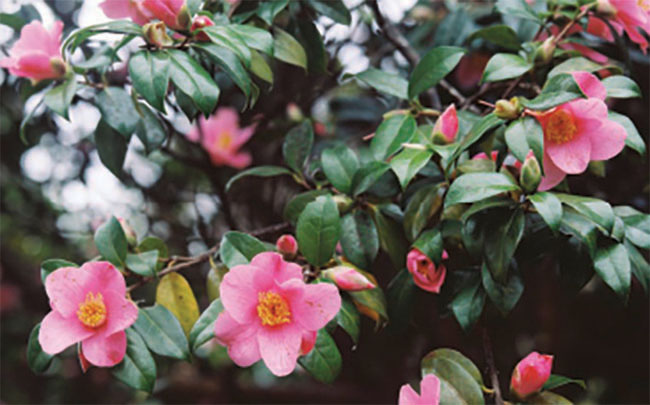
Catherine has been thinking outside of the box for Valentine’s Day.
How on earth did flowers, especially red roses, become symbolic of such an ancient festival as Valentine’s Day in England? I’ve checked my Wildflowers of Britain book and it confirms my certainty that the only native flowers which bloom in February are hazel and poplar catkins or snowdrops, neither of which is usually associated with romance, and even snowdrops may not be truly native, merely naturalised.
This started me thinking about giving alternative flowers to imported red roses as a token of our love, not only because I worry about the very unlovely impact on our climate but also because they completely lack the essential sensuality of fragrance, surely an indispensable part of romance?
There are some garden flowers which cheer us on the gloomiest February day and remind us of the sultry summer days we hope will come. As there are so few brave insects on the wing at this time of year these flowers have to work extra hard to attract their attention and most often they do this by widely diffusing their scent on the winter air, especially when they can be positioned to capture elusive sunlight. One of my favourites is the shrub honeysuckle, Lonicera fragrantissima Even the name rolls voluptuously from the tongue and sounds reminiscent of an operatic instruction. It has small creamy flowers on bare branches. I have one by my front door and it is wonderfully welcoming on a chilly February day. It is a bit of a passenger in the summer, although it can be threaded through with a summer flowering climber, but it is such a treat in winter that it is worth it.
The Daphne family offers us even more romantic beauties. Appropriately named after the beautiful nymph adored by Apollo of Greek mythology, they have soft pink flowers and an intense scent. Most of these also have handsome evergreen leaves and are a positive asset in the smallest gardens all the year round. I am especially fond of D. bholua Jacqueline Postill as it is so free flowering but there are many varieties from which to choose.
Wintersweet is a name descriptive enough to need no further explanation, although its botanical name, Chimonanthus praecox, is less romantic. It is a shrub bearing small, red flushed, pale yellow flowers. Wintersweet is happy to grow on chalky soil and even happier if you can train it on a sunny wall, ideally where you can enjoy a morning coffee nearby.

If you feel bewitched by your sweetheart, try the witch hazel Hamamelis with its spidery warm yellow blooms and sweet, spicy scent. It is widely planted in the winter garden although it needs acid soil to thrive. The leaves of some varieties also turn a rich red in autumn.
Osmanthus burkwoodii and O. delavayii have richly scented jasmine like flowers in early spring. The leaves are small and neat and the plants grow readily in sun or shade. I’ve planted hedges of osmanthus as they can be formally clipped as well as allowed to grow into billowing fragrant forms. These are more plants for the welcoming front garden.
Other plants are scentless but rely on conspicuous flowers. Camellias are the ultimate sensuous flower with their sumptuous pink, white or red blooms. Alexandre Dumas clearly thought so when he named his romantic tragedy The Lady of the Camellias. They dislike lime and in the wild enjoy a woodland edge habitat.
Hellebores are naturally variable in their flower colour. They have been bred in many different forms and shades from doubles to singles and frilly picotee. Like the bees, I prefer the simplicity of single forms and for Valentine’s Day I would choose the luxurious dark red H. x hybridus “Queen of the Night” but, if frills are more your style, try the appropriately named H. x hybridus Party Dress Group with their pink streaked white double flowers.
For hearts we can look to the beautifully marbled leaves of Cyclamen hederifolium. These are produced in winter after the autumn flowers. If you plant the tubers of these with the nodding flowers of magenta or pink C. coum you can enjoy both blooms and leaves at once. I think next year I’ll try making a heart shaped wreath of cyclamen flowers and leaves.
So this year why not create your own Valentine’s Day bouquet with some of your own garden flowers? If too late this year, try to plan ahead by planting some sumptuous camellias or hellebores, combining them with fragrant daphne, osmanthus or honeysuckle and perhaps some cyclamen for a beautiful romantic gesture.
